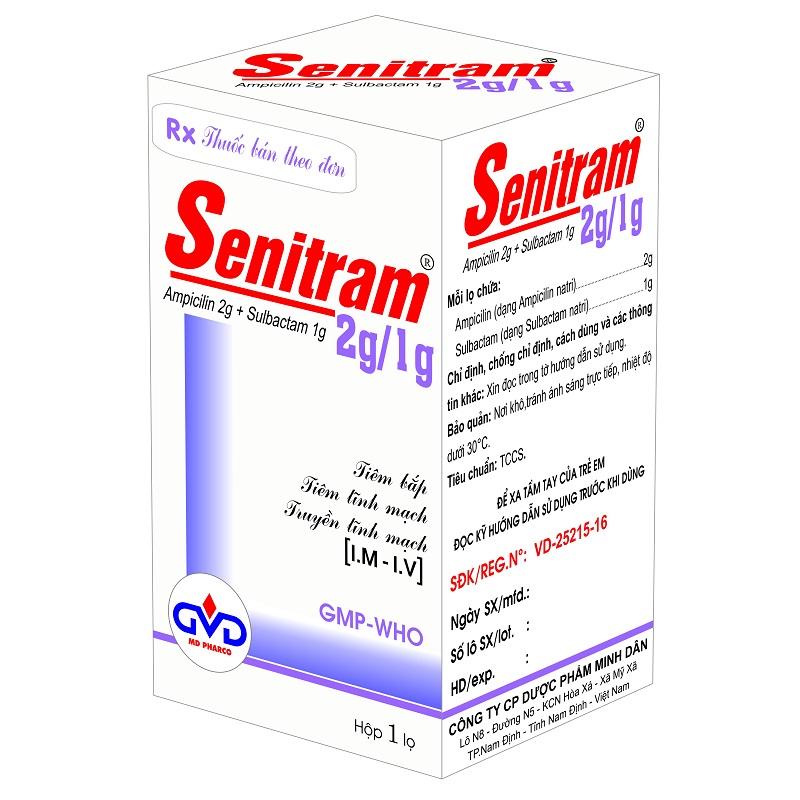What is Senitram (ampicillin + sulbactam)?
This drug combination is used to treat a wide range of bacterial infections. It is known as the penicillin antibiotic. It works by stopping the growth of bacteria.
How should you take ampicillin + sulbactam?
The drug is given intravenously, usually every 6 hours or as directed by a physician. The dosage is based on your health condition and your treatment. For children, dosage is also based on weight. If you take this medicine yourself at home, find out all the preparation and instructions from your doctor. Before use, check the product for grain or discoloration. If one of the above phenomena occurs, do not use liquid. Learn how to safely store and dispose of medical supplies.
Use aminoglycosides (such as gentamicin) separately with this drug. Do not mix when injected intravenously.
Antibiotics work best when the amount of medicine in your body is kept stable. So take them at regular intervals. Continue to use the medication until adequate dosage is prescribed, even if the symptoms disappear after a few days. Stopping too soon can cause the bacteria to continue to develop, which can lead to re-infection. Let your doctor know if your condition persists or worsens.
How to preserve ampicillin + sulbactam?
Your doctor will probably give you ampicillin and sulbactam for several days at the same time. If you inject ampicillin and sulbactam through the vein, you need to store it in a refrigerator or freezer.
Take the next dose from the refrigerator 1 hour before using it; Place the medication in a clean, dry place to help keep it warm at room temperature.
If you are told to keep ampicillin and sulbactam in the freezer, keep the 24-hour medicine in the cooler for future use.
Different drug labels may have different storage requirements. Check the package for instructions on how to store the medication, or ask your pharmacist. Keep all medicines out of the reach of children and pets.
Do not throw the medicine in the toilet or plumbing unless required. Dispose of properly when the drug is expired or unusable. Consult your local pharmacist or local waste disposal company for safe disposal.
Dosage
The information provided can not substitute for the advice of the medical professional. Always consult your doctor or pharmacist before making any decisions.
What is the dose of ampicillin + sulbactam for adults?
Regular doses for adults with vocal cord inflammation
Intravenous 1.5-3 g intravenously every 6-8 hours. Continue the injection until the patient's condition is stable, then start taking the appropriate antibiotic.
Regular doses for adults with deep infections in the neck
Intravenous 1.5-3 g intravenously every 6-8 hours. Continue the injection until the patient's condition is stable, then start taking the appropriate antibiotic.
Dose for adults with lung injury due to inhalation
Intravenous 1.5-3 g intravenously every 6-8 hours. Continue the injection until the patient's condition is stable, then start taking the appropriate antibiotic.
Dose for adults with intra-abdominal infections
Intravenous 1.5-3 g every 6-8 hours for 7 to 14 days, depending on the nature and severity of the infection.
Dosage for adults with arthritis
1.5-3 g intravenously or intramuscularly every 6-8 hours for 3-4 weeks, depending on the nature and severity of the infection. Treatment may take longer, for 6 weeks or more, for a false-positive joint infection.
Doses for adults with bone marrow inflammation
1.5-3 g intravenously or intramuscularly every 6-8 hours for 4-6 weeks, depending on the nature and severity of the infection. Chronic myeloid disease may require combination therapy, which may be up to 6 months.
Dose for pelvic inflammatory disease
1.5-3 g intravenously or intramuscularly every 6-8 hours. Injection therapy should be continued for at least 48 hours after detecting clinical improvement signs. It can then be replaced by oral medication to complete the course of treatment for 14 days.
Dose for peritonitis
1.5-3 g intravenously every 6-8 hours for 10 to 14 days, depending on the nature and severity of the infection.
Dose for adults with pneumonia
1.5-3 g intravenously or intramuscularly every 6-8 hours. Treatment should be continued for 7 days, if pneumococcal pneumonia is suspected up to 21 days, if the disease is caused by other organisms.
Dosage for adults with pyelonephritis
1.5-3 g intravenously or intramuscularly every 6-8 hours. Injection therapy should continue until the patient is clinically stable at the time, and then may be replaced by oral medication to complete the course for 14 days.
Dose for skin or soft tissue infections
1.5-3 g intravenously or intramuscularly every 6-8 hours for 7 to 10 days, or intravenous injection within 3 days after acute inflammation, depending on the nature and severity of infection.
Surgical Prophylaxis
Intramuscular / intravenously 1.5-3 g once prior to anesthesia. Can continue to use every 6 hours within 24 hours if needed.
Dosage for adults with urinary tract infections
1.5 g intravenously or intramuscularly every 6 hours for 3-7 days, depending on the nature and severity of the infection.
What is the dose of ampicillin + sulbactam for children?
The usual dose for children with meningitis
1 month to 1 year: intravenous 50-75 mg / kg (ampicillin) every 6 hours.
1 to 12 years of age: 50-100 mg / kg (ampicillin) intravenously every 6 hours.
Maximum dose: 8 g ampicillin / 24 hours.
What are the forms and levels of ampicillin + sulbactam?
Ampicillin + sulbactam has the following form and content:
Powdered solution of 1.5 g (ampicillin 1 g sulbactam plus 0.5 g).
3 g of ampicillin (2 g sulbactam plus 1 g). Powdered solution of 15 g (ampicillin 10 g sulbactam plus 5 g).
Side effects
What side effects will you have with ampicillin + sulbactam?
Get an emergency if you have any signs of allergy: rash; shortness of breath; swollen face, lips, tongue, or throat.
Call your doctor right away if you have any serious side effects:
Fever, sore throat and severe blistering, peeling and rash;
Diarrhea or bloody diarrhea;
Fever, chills, body aches, flu symptoms.
Less serious side effects may include:
Nausea, vomiting, abdominal pain, flatulence;
Vaginal itching or discharge;
Headache;
Itchy;
The tongue is swollen, black, or spiny;
Mushrooms (white spots within the mouth or throat);
Pain, swelling, or discomfort in the injection site.
Not all of these side effects are present. There may be other side effects not mentioned. If you have any questions about side effects, consult your doctor or pharmacist.
Caution / Warning
Before taking ampicillin + sulbactam what should you know?
Before taking ampicillin and sulbactam, you should:
Talk to your doctor and pharmacist if you are allergic to ampicillin, penicillin, cephalosporin [eg, cefaclor (Ceclor), cefadroxil (Duricef), or cephalexin (KEFLEX)], or any other medication.
Talk to your doctor and pharmacist about prescription and over-the-counter medicines you are taking, especially other antibiotics, allopurinol (Lopurine), anticoagulants such as warfarin (Coumadin), atenolol (tenormin) , birth control pills, probenecid (Benemid), rifampin (rifadine), sulfasalazine, and vitamins.
Talk to your doctor if you have or have had asthma, seasonal fever, kidney disease or gastrointestinal (especially colitis).
Talk to your doctor if you are pregnant, planning to become pregnant, or are breastfeeding. If you are pregnant while taking ampicillin and sulbactam, call your doctor.
If you have diabetes and have regular checkups for sugar in your urine, use Clinistix or TesTape. Do not use Clinitest tablets because ampicillin and sulbactam may produce false positive results.
Things to keep in mind if you are pregnant or breastfeeding
There are no adequate studies to determine the risk of this drug during pregnancy or lactation. Before taking medicine, always consult your doctor to weigh the benefits and risks. This drug belongs to group B for pregnancy.
Note: Pregnancy Category:
A = no risk;
B = No risk in some studies;
C = Possible risk;
D = evidence of risk;
X = contraindications;
N = Not yet known.
Drug interactions
What are the side effects of ampicillin plus sulbactam?
Drug interactions can alter the ability of the drug or increase the effect of side effects. This document does not cover all possible drug interactions. Write a list of what you are taking (including prescription and over-the-counter medications) and your doctor or pharmacist. Do not take medication, discontinue or change the dose without permission of the physician.
Tetracycline (eg doxycycline) as they may reduce the efficacy of ampicillin / sulbactam.
Probenecid may increase the risk of side effects of ampicillin / sulbactam.
Allopurinol because of increased risk of skin rash.
Heparin because of increased risk of bleeding.
Methotrexate may increase the risk of side effects of ampicillin / sulbactam.
Anticoagulants (eg warfarin) as the effect of the drug may be reduced or increased risk of side effects by ampicillin / sulbactam.
Aminoglycosides (eg gentamicin), oral contraceptives, or direct oral oral vaccine should be avoided as the effect of the drug may be reduced by ampicillin / sulbactam.
Does food and alcohol affect ampicillin + sulbactam?
Certain drugs should not be taken at meals or at the same time as certain foods because of possible interactions. Alcohol and cigarettes can also interact with certain drugs. Consult your health professional about taking medication along with food, alcohol and tobacco.
What health condition affects ampicillin + sulbactam?
Your health status may affect the use of this medication. Tell your doctor if you have any health problems, especially:
Diarrhea - Use with caution. Can make this situation worse.
Kidney disease - use with caution. The effects can be increased by slower removal from the body.
History of liver disease (eg, cholestatic jaundice).
Mononucleosis - should not be used in patients with this condition.
Emergency / Overdose
What should you do in an emergency or overdose?
In an emergency or overdose, call the nearest emergency center 115 or go to the nearest local health unit.
What should I do if I forget a dose?
If you forget to take a dose, use as soon as possible. If, however, close to the next dose, skip the missed dose and take the next dose at the scheduled time. Do not double the prescribed dose.




